Spatiotemporal Evolution and Driving Factors of Groundwater in Beijing Sub-Center
Abstract
1. Introduction
2. Materials and Methods
2.1. Study Area
2.2. Method
2.2.1. Continuous Wavelet Transform (CWT)
2.2.2. Geostatistical Model
2.2.3. Grey Relational Analysis
- Let X′ = (x′1, x′2, …, x′n) represent the series of the i-th influencing factor in the t-th period, and Y′ = (y′1, y′2, …, y′n) represent the groundwater level series corresponding to the i-th influencing factor in the t-th period. To eliminate the effect of the dimension, the original data are normalized as follows:
- 2.
- Calculate the maximum and minimum absolute differences between the corresponding values in the two series:
- 3.
- Calculate the grey relational coefficient:
- 4.
- Compute the grey relational grade:
3. Results
3.1. Continuous Wavelet Transform of Groundwater Level
3.2. Geostatistical Model Analysis
3.2.1. Cross-Validation of the Semivariogram Model
3.2.2. Analysis of Spatial Variability of Groundwater Levels
3.3. Grey Relational Analysis of Driving Factors for Groundwater Level
4. Discussion
4.1. Rationality of the Groundwater Level Spatiotemporal Evolution Pattern
4.2. Analysis of the Driving Mechanism of Groundwater Level Changes
5. Conclusions
- The groundwater level variations from 1980 to 2020 are primarily governed by three main cycles corresponding to characteristic time scales of 60, 40, and 20 years. At the 50–64-year time scale, there is one full wet–dry oscillation observed across the entire study area. At the 30–47-year time scale, there are approximately 1.5 wet–dry cycles across the region. The 20-year time scale exhibits multiple less-distinct fluctuations, indicating weaker periodicity. At the 40-year characteristic time scale, the average cycle duration is around 26 years, showing two full wet–dry transitions. The average variation cycle of groundwater levels at the 60-year characteristic time scale is around 40 years, experiencing one incomplete wet–dry transition period. It can also be predicted that, after 2020, the groundwater level at Liyuan Station will remain in a dry period, but the decreasing trend will gradually slow down.
- From 1980 to 2000, groundwater levels in Tongzhou District declined across the entire region, with the central area experiencing a smaller rate of decline compared to the northern and southern regions. Between 2000 and 2010, groundwater levels in central areas such as Lucheng Town, Majuqiao Town, and the eastern part of Xiji Town rebounded significantly, while declines continued in the northern and southern regions. From 2010 to 2020, the most notable groundwater level decline occurred in the northern region, while increases were observed in Majuqiao Town and Lucheng Town. During the periods 1980–1990, 2000–2010, and 2010–2020, groundwater level variations exhibited strong spatial correlation, primarily influenced by structural spatial factors and less affected by random external factors. From 1990 to 2000, groundwater level variations showed moderate spatial correlation, influenced by both structural factors such as topography and geomorphology, and stochastic external factors such as human activities and climate.
- From 2011 to 2020, the grey relational grades of water usage in the study area were ranked as follows: domestic water usage (γ01) > tertiary sector water usage (γ02) > industrial water usage (γ03). Due to rapid population growth and regional economic development, living standards improved significantly, leading to a synchronized increase in water demand. As a result, domestic, tertiary sector, and industrial water usages show a strong correlation with groundwater level changes, indicating a significant impact from these sectors on groundwater resources. Agricultural water usage (γ04) had the lowest grey relational grade, suggesting a decreasing influence on groundwater levels during this period. This trend is associated with changes in agricultural development planning in the region, including reductions in both total crop sown area and actual area used for facility agriculture.
Author Contributions
Funding
Data Availability Statement
Conflicts of Interest
References
- Tziritis, E.; Panagopoulos, A. Geo-environmental approaches for the analysis and assessment of groundwater resources at the catchment scale. Water 2022, 14, 1085. [Google Scholar] [CrossRef]
- Yin, Z.; Xu, Y.; Zhu, X.; Zhao, J.; Yang, Y.; Li, J. Variations of groundwater storage in different basins of China over recent decades. J. Hydrol. 2021, 598, 126282. [Google Scholar] [CrossRef]
- Xue, F.; Zhang, N.; Xia, C.; Zhang, J.; Wang, C.; Li, S.; Zhou, J. Spatial evaluation of urban ecological resilience and analysis of driving forces: A case study of Tongzhou District, Beijing. Acta Ecol. Sin. 2023, 43, 6810–6823. (In Chinese) [Google Scholar]
- Lin, X.; Li, W.; Wang, H.; Ming, D.; Han, L. Analysis of the groundwater storage variations and their driving factors in the three eastern coastal urban agglomerations of China. Remote Sens. Nat. Resour. 2022, 34, 262–271. (In Chinese) [Google Scholar]
- Zhao, Z.; Luo, Z.; Huang, L.; Xing, L.; Li, H.; Sun, H. Research on the response mechanism of groundwater level to rainfall in the western suburb of Jinan based on wavelet analysis. Carsologica Sin. 2023, 42, 931–939. (In Chinese) [Google Scholar]
- Guo, L.; Gong, H.; Zhu, F.; Guo, X.; Zhou, C.; Qiu, L. Cyclical characteristics of groundwater level and precipitation based on wavelet analysis. Geogr. Geo-Inf. Sci. 2014, 30, 35–38+127. (In Chinese) [Google Scholar]
- Yang, P.; Zhang, S.; Guo, B.; Yang, C.; Feng, Q.; Lv, Y.; Xie, L. Characteristic of groundwater level dynamic variation and the potential influence factors in different aquifer categories in Rizhao area, Shandong province. J. Jilin Univ. (Earth Sci. Ed.) 2024, 54, 967–979. (In Chinese) [Google Scholar] [CrossRef]
- Zhang, H.; Rui, X.; Zhou, Y.; Sun, W.; Xie, W.; Gao, C.; Ren, Y. Analysis of the response of shallow groundwater levels to precipitation based on different wavelet scales—A case study of the Datong Basin, Shanxi. Water 2024, 16, 2920. [Google Scholar] [CrossRef]
- Tsai, J.-P.; Hsiao, C.-T. Spatiotemporal analysis of the groundwater head variation caused by natural stimuli using independent component analysis and continuous wavelet transform. J. Hydrol. 2020, 590, 125405. [Google Scholar] [CrossRef]
- Gordu, F.; Nachabe, M.H. A physically constrained wavelet-aided statistical model for multi-decadal groundwater dynamics predictions. Hydrol. Process. 2021, 35, e14308. [Google Scholar] [CrossRef]
- Dadhich, A.P.; Goyal, R.; Dadhich, P.N. Assessment and prediction of groundwater using geospatial and ANN modeling. Water Resour. Manag. 2021, 35, 2879–2893. [Google Scholar] [CrossRef]
- Gong, G.; Mattevada, S.; O’Bryant, S.E. Comparison of the accuracy of kriging and IDW interpolations in estimating groundwater arsenic concentrations in Texas. Environ. Res. 2014, 130, 59–69. [Google Scholar] [CrossRef]
- Shrestha, N.; Mittelstet, A.; Young, A.R.; Gilmore, T.E.; Gosselin, D.C.; Qi, Y.; Zeyrek, C. Groundwater level assessment and prediction in the Nebraska Sand Hills using LIDAR-derived lake water level. J. Hydrol. 2021, 600, 126582. [Google Scholar] [CrossRef]
- Wang, Q.; Sun, J.; Yang, Y.; Zhang, J.; Wang, G.; Ma, E.; Liu, J.; Zhao, X. A comparative study of Kriging and deep learning methods for shallow groundwater level estimation: A case study of the Shenzhen-Shanwei Special Cooperation Zone. Bull. Geol. Sci. Technol. 2024, 43, 291–301. (In Chinese) [Google Scholar] [CrossRef]
- Tao, C.; Dan, P.; Mat, G. Gaussian process machine learning and Kriging for groundwater salinity interpolation. Environ. Model. Softw. 2021, 144, 105170. [Google Scholar] [CrossRef]
- Celicourt, P.; Gumiere, S.J.; Lafond, J.A.; Gumiere, T.; Gallichand, J.; Rousseau, A.N. Automated Mapping of Water Table for Cranberry Subirrigation Management: Comparison of Three Spatial Interpolation Methods. Water 2020, 12, 3322. [Google Scholar] [CrossRef]
- Shyam, M.; Meraj, G.; Kanga, S.; Sudhanshu; Farooq, M.; Singh, S.K.; Sahu, N.; Kumar, P. Assessing the Groundwater Reserves of the Udaipur District, Aravalli Range, India, Using Geospatial Techniques. Water 2022, 14, 648. [Google Scholar] [CrossRef]
- Zhang, Y.; Shi, Y.; Sun, C.; An, T.; He, W.; Fan, Q.; Luo, Z.; Shi, H. Effect of Groundwater Level Rise Rebound on Nitrate Nitrogen in Miyun-Huairou-Shunyi Recharge Area. Environ. Pollut. Control 2023, 45, 1496–1501. (In Chinese) [Google Scholar] [CrossRef]
- Zhu, Q.; Zhao, H.; Wang, J.; Liu, T. Analysis of dynamic changes and influencing factors of groundwater level in Beijing. Beijing Water 2024, 03, 49–54. (In Chinese) [Google Scholar] [CrossRef]
- Wang, W.; Tian, H.; Yang, G.; Liu, B.; Pan, Y.; Ding, G.; Xu, X.; Dan, Y.; Cui, M.; Gao, Y. Dynamic variation of groundwater level and its influencing factors in typical oasis irrigated areas in Northwest China. Open Geosci. 2023, 15, 20220493. [Google Scholar] [CrossRef]
- Yan, B.; Li, X.; Hou, J.; Bi, P.; Sun, F. Study on the dynamic characteristics of shallow groundwater level under the influence of climate change and human activities in Cangzhou, China. Water Sci. Technol. Water Supply 2020, 21, 797–814. [Google Scholar] [CrossRef]
- Li, X.; Li, G.; Zhang, Y. Identifying major factors affecting groundwater change in the North China Plain with Grey Relational Analysis. Water 2014, 6, 1581–1600. [Google Scholar] [CrossRef]
- Zhang, M.; Ping, J.; Mei, X.; Leng, W.; Li, H.; Zhao, J.; Liu, J. The trend of groundwater recharge in the secondary perched reaches of the Yellow River in the past 50 years. Front. Environ. Sci. 2023, 11, 1310181. [Google Scholar] [CrossRef]
- Zuo, B.; Xu, Z.; Ren, M.; Li, P. Precipitations in Tongzhou District Beijing from 1966–2016. J. Beijing Norm. Univ. (Nat. Sci.) 2019, 55, 556–563. (In Chinese) [Google Scholar] [CrossRef]
- Li, B.; Yu, L.; Pan, X.; Jun, Q.; Zhang, Y.; Zhao, L.; Yang, M. Temporal and spatial characteristics of precipitation in Tongzhou District, Beijing. J. Beijing Norm. Univ. (Nat. Sci.) 2020, 56, 566–572. (In Chinese) [Google Scholar]
- Du, D.; Liu, H.; Zhou, J.; Zhang, J.; Miao, J.; Li, Y.; Cao, X.; Ye, M. Study of the characteristics and influencing factors of land subsidence in the Tongzhou district of Beijing. Acta Geol. Sin. 2022, 96, 712–725. (In Chinese) [Google Scholar] [CrossRef]
- Wang, X.; Li, B.; Li, Y.; Jiang, X.; Jiang, C.; Gao, J. Hydrochemistry of groundwater in quaternary aquifers in Tongzhou of Beijing and the underlying determinants. J. Irrig. Drain. 2022, 41, 92–97+104. (In Chinese) [Google Scholar] [CrossRef]
- Wang, Q.; Guo, X.; Duan, X.; Wang, S.; Zuo, R.; Wang, J.; Liu, X.; Zhai, Y.; Meng, L. Identification and correlation of sensitive indicators for groundwater quality in South water recharge areas. J. Beijing Norm. Univ. (Nat. Sci.) 2023, 59, 288–298. (In Chinese) [Google Scholar]
- Bahmani, R.; Solgi, A.; Ouarda, T.B.M.J. Groundwater level simulation using gene expression programming and M5 model tree combined with wavelet transform. Hydrol. Sci. J. 2020, 65, 1430–1442. [Google Scholar] [CrossRef]
- Zhao, J.; Li, G.; Zhu, Z.; Hao, Y.; Hao, H.; Yao, J.; Bao, T.; Liu, Q.; Yeh, T.C.J. Analysis of the spatiotemporal variation of groundwater storage in Ordos Basin based on GRACE gravity satellite data. J. Hydrol. 2024, 632, 130931. [Google Scholar] [CrossRef]
- Liu, J.; Song, M.; Zang, C.; Yin, R. Research on variation of groundwater depth and key influencing factors in Songliao Plain. J. North China Univ. Water Resour. Electr. Power (Nat. Sci. Ed.) 2021, 42, 58–65. (In Chinese) [Google Scholar] [CrossRef]
- Thakur, B.; Kaur, S.; Verma, V.K.; Biswas, A. Geostatistical evaluation and network optimization for precision groundwater resource mapping and management in Punjab State, India. Hydrogeol. J. 2025, 33, 591–609. [Google Scholar] [CrossRef]
- Sun, Y.; Kang, S.; Li, F.; Zhang, L. Comparison of interpolation methods for depth to groundwater and its temporal and spatial variations in the Minqin oasis of northwest China. Environ. Model. Softw. 2009, 24, 1163–1170. [Google Scholar] [CrossRef]
- Theodossiou, N.; Latinopoulos, P. Evaluation and optimisation of groundwater observation networks using the Kriging methodology. Environ. Model. Softw. 2006, 21, 991–1000. [Google Scholar] [CrossRef]
- Liu, Y.; Sun, G.; Mao, W.; Cheng, X.; Zhu, Y.; Yang, J. Geostatistical analysis of spatial variability of soil water and salt in Hetao Irrigation District. J. Irrig. Drain. 2022, 41, 101–109. (In Chinese) [Google Scholar] [CrossRef]
- Wang, Y.; Wu, X.; Liu, Z.; Shi, L. Characteristics and trend prediction of groundwater chemical evolution under the influence of sea water in the Jiaojia Gold Mining Area, China. Mine Water Environ. 2024, 43, 53–72. [Google Scholar] [CrossRef]
- Bian, J.; Sun, X. Comparison of three methods for uncertainty analysis of hydrologic models. J. China Hydrol. 2012, 32, 24–27+20. (In Chinese) [Google Scholar]
- Men, B.; Zhang, T. Component analysis and stochastic simulation of precipitation series in Beijing during the last 300 years. J. Hydraul. Eng. 2022, 53, 686–696+711. (In Chinese) [Google Scholar] [CrossRef]
- Beijing Tongzhou Statistical Yearbook 2021. Available online: https://www.bjtzh.gov.cn/bjtz/xxfb/202112/1502482.shtml (accessed on 24 March 2025).
- Wei, L.; Hao, S.; Wang, C.; Cao, L.; Chen, B. Effect of reclaimed water reuseage on groundwater level in Tongzhou District based on GIS. J. Irrig. Drain. 2014, 33, 301–305. (In Chinese) [Google Scholar] [CrossRef]

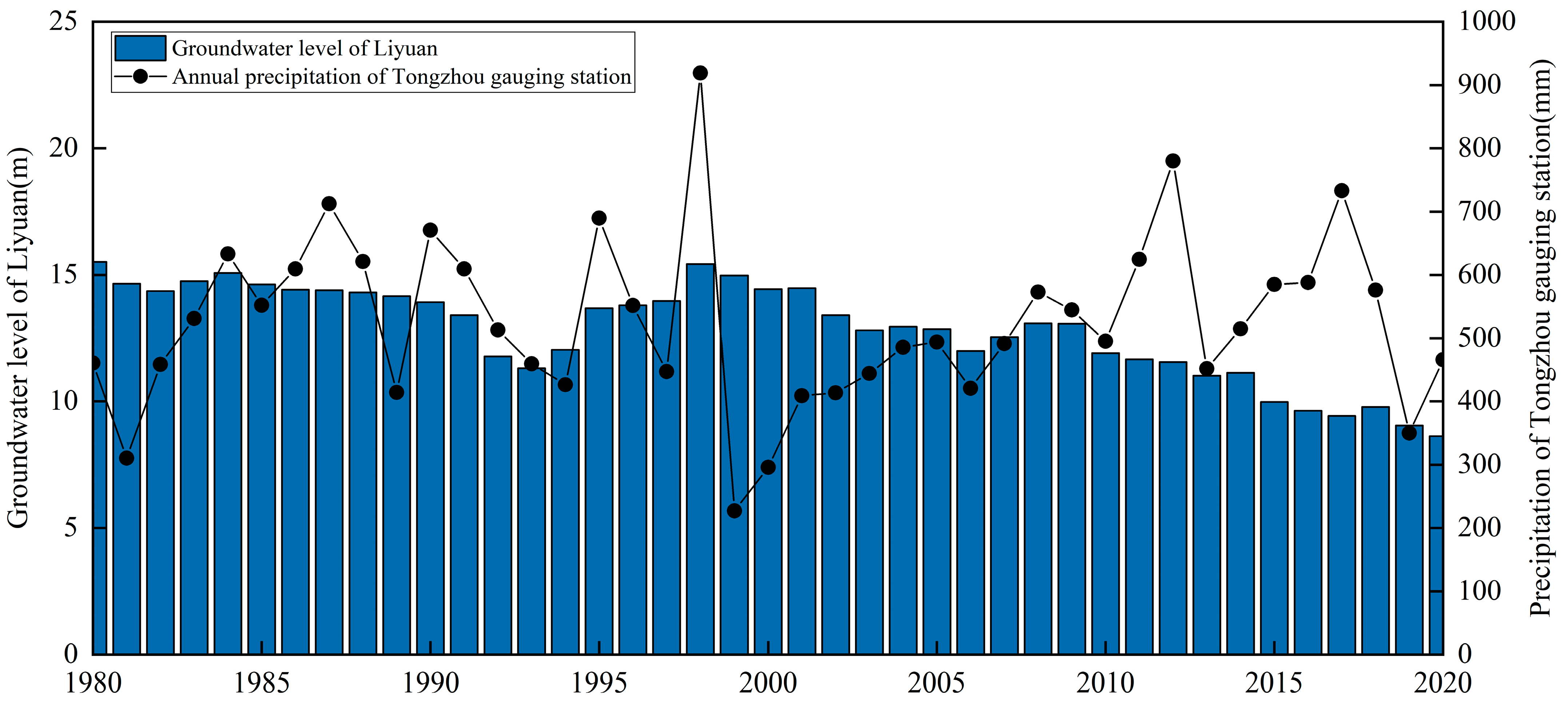
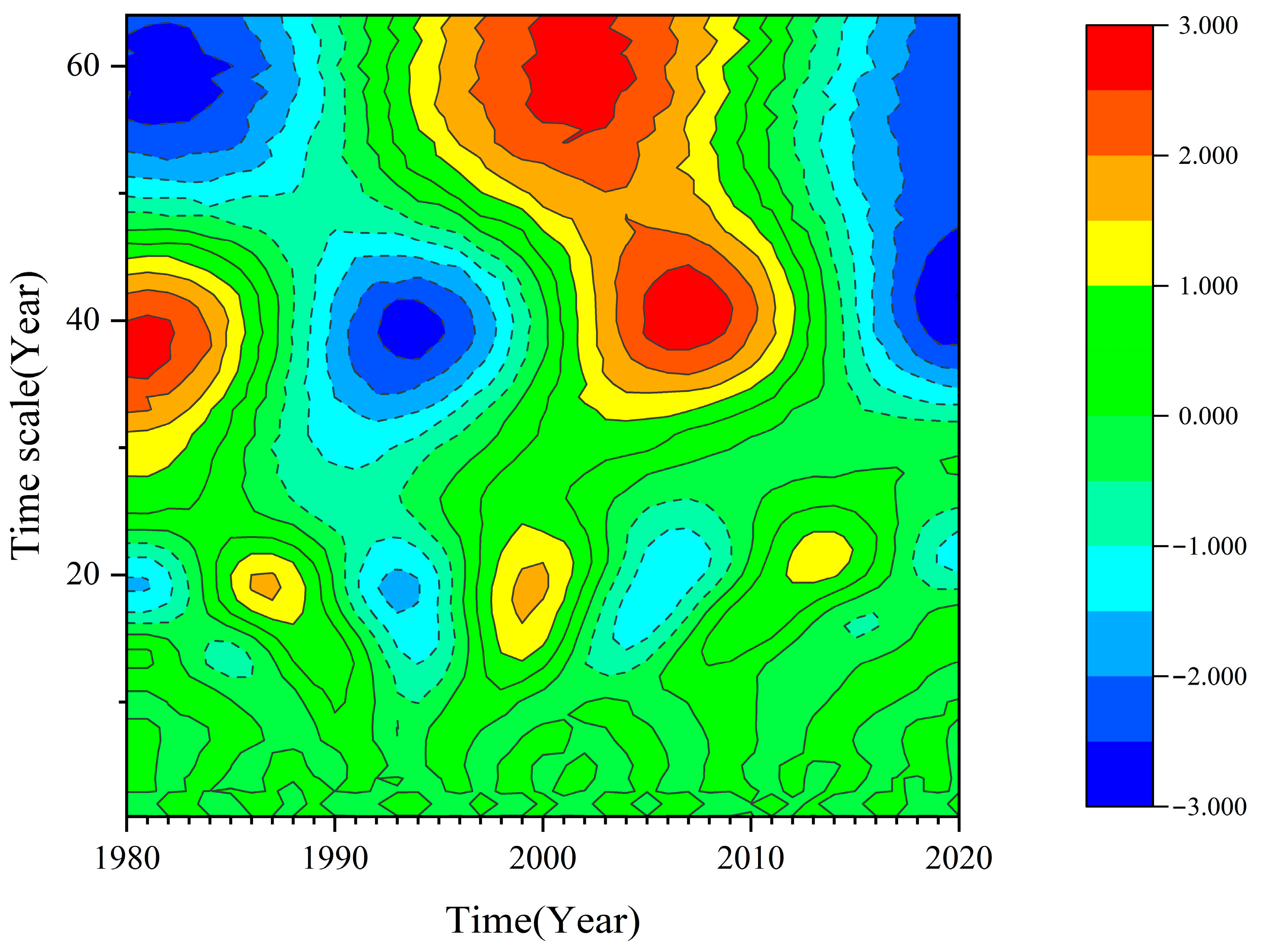
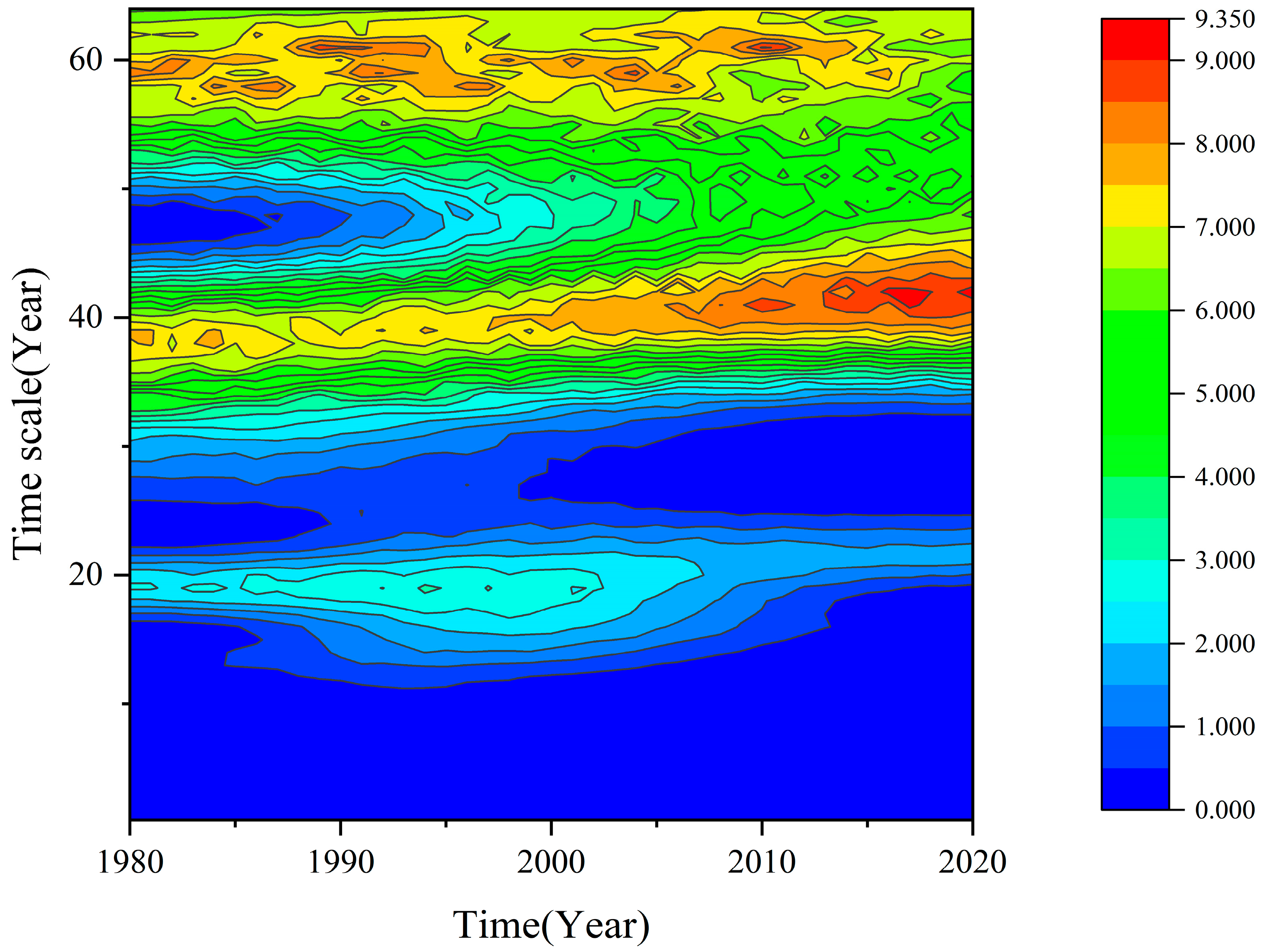

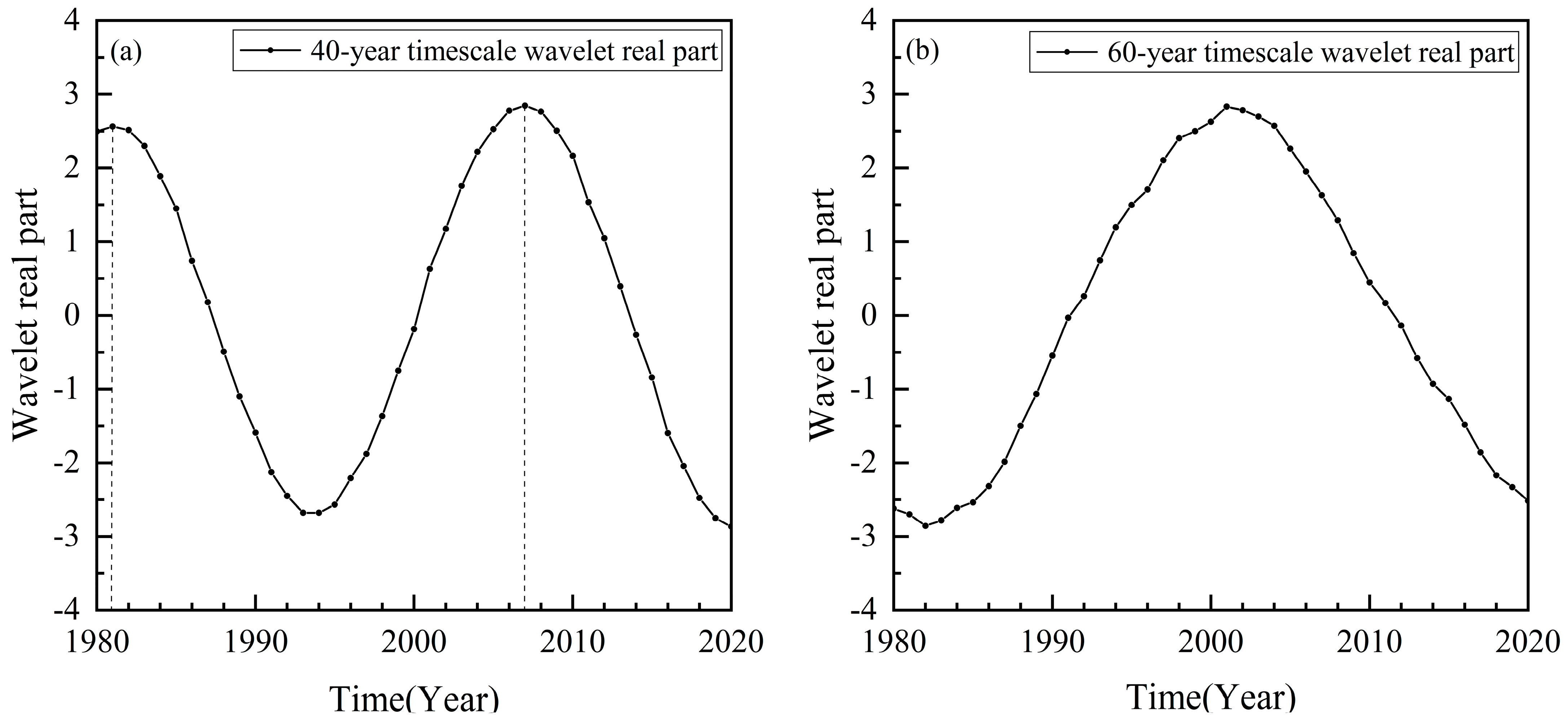
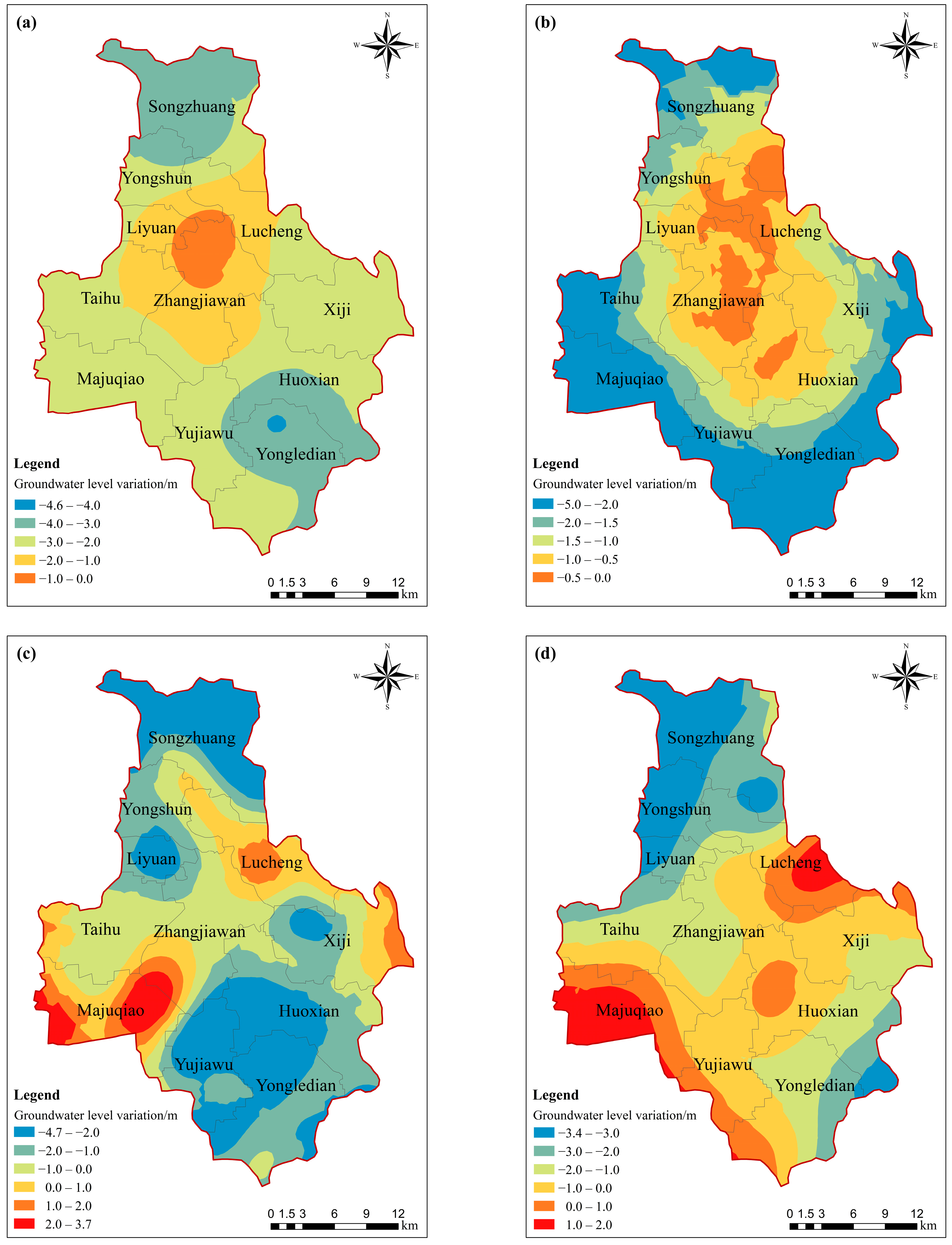
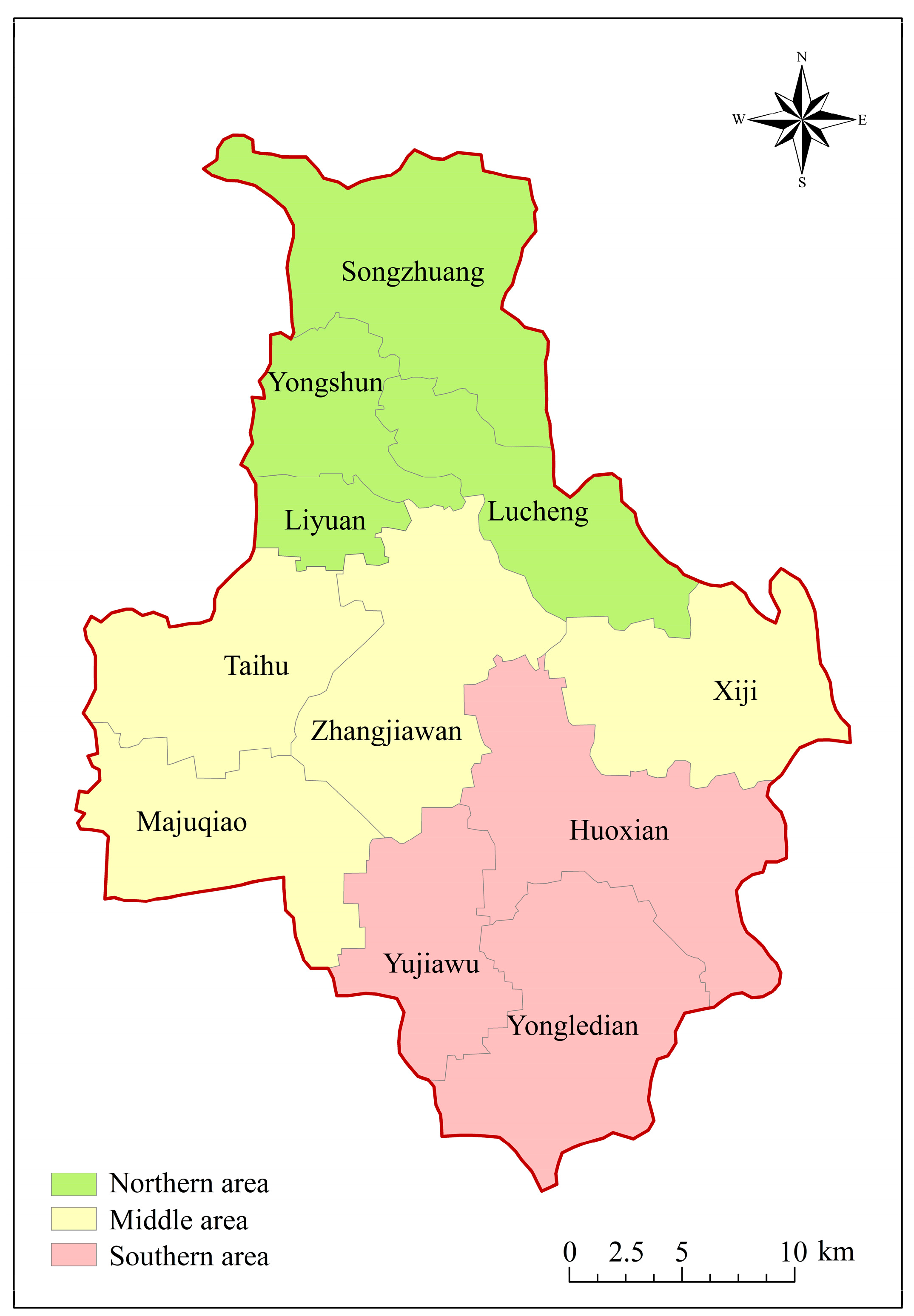

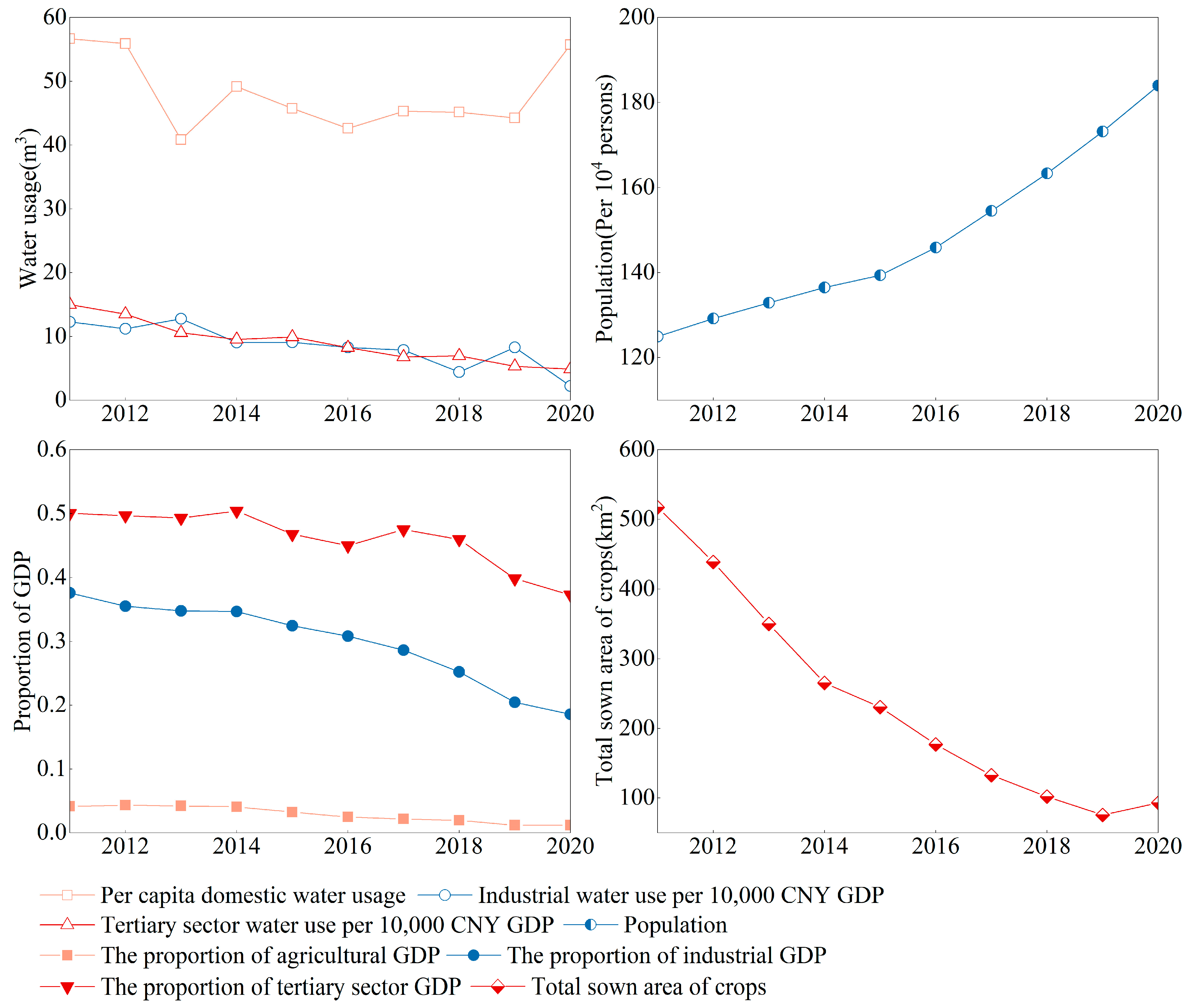
| Time | 1980–1990 | 1990–2000 | 2000–2010 | 2010–2020 |
|---|---|---|---|---|
| Significance | 0.159 | 0.442 | 0.652 | 0.538 |
| Time | Model | ME | RMSE | ASE |
|---|---|---|---|---|
| 1980–1990 | Spherical model | −0.062 | 0.860 | 0.692 |
| Exponential model | −0.056 | 0.912 | 0.733 | |
| Gaussian model | −0.065 | 0.850 | 0.685 | |
| 1990–2000 | Spherical model | −0.0003 | 1.319 | 1.098 |
| Exponential model | 0.012 | 1.323 | 1.100 | |
| Gaussian model | −0.010 | 1.326 | 1.083 | |
| 2000–2010 | Spherical model | 0.023 | 2.187 | 1.811 |
| Exponential model | 0.053 | 2.214 | 1.827 | |
| Gaussian model | −0.012 | 2.173 | 1.720 | |
| 2010–2020 | Spherical model | 0.179 | 1.282 | 0.995 |
| Exponential model | 0.160 | 1.345 | 1.042 | |
| Gaussian model | 0.185 | 1.251 | 0.996 |
| Year | Semivariogram | Nugget | Partial Sill | Sill | Nugget Effect (%) |
|---|---|---|---|---|---|
| 1980–1990 | Gaussian model | 0.165 | 0.726 | 0.891 | 18.519 |
| 1990–2000 | Spherical model | 0.785 | 0.308 | 1.093 | 71.821 |
| 2000–2010 | Gaussian model | 0.208 | 3.879 | 4.087 | 5.089 |
| 2010–2020 | Gaussian model | 0.209 | 1.367 | 1.576 | 13.261 |
| Driving Factors | Sub-Driving Factors | Grey Relational Grade |
|---|---|---|
| Domestic water usage | Per capita domestic water usage (γ1) | 0.87 |
| Population (γ2) | 0.83 | |
| Industrial water usage | Industrial water use per 10,000 CNY GDP (γ3) | 0.76 |
| The proportion of industrial GDP (γ4) | 0.81 | |
| Tertiary sector water usage | The proportion of tertiary sector GDP (γ5) | 0.92 |
| Tertiary sector water use per 10,000 CNY GDP (γ6) | 0.72 | |
| Agricultural water usage | The proportion of agricultural GDP (γ7) | 0.64 |
| Total sown area for crops (γ8) | 0.60 |
Disclaimer/Publisher’s Note: The statements, opinions and data contained in all publications are solely those of the individual author(s) and contributor(s) and not of MDPI and/or the editor(s). MDPI and/or the editor(s) disclaim responsibility for any injury to people or property resulting from any ideas, methods, instructions or products referred to in the content. |
© 2025 by the authors. Licensee MDPI, Basel, Switzerland. This article is an open access article distributed under the terms and conditions of the Creative Commons Attribution (CC BY) license (https://creativecommons.org/licenses/by/4.0/).
Share and Cite
Xue, X.; Gu, X.; Du, Y.; Zhang, N.; Yin, S. Spatiotemporal Evolution and Driving Factors of Groundwater in Beijing Sub-Center. Water 2025, 17, 1668. https://doi.org/10.3390/w17111668
Xue X, Gu X, Du Y, Zhang N, Yin S. Spatiotemporal Evolution and Driving Factors of Groundwater in Beijing Sub-Center. Water. 2025; 17(11):1668. https://doi.org/10.3390/w17111668
Chicago/Turabian StyleXue, Xiaowei, Xueye Gu, Yicun Du, Ning Zhang, and Shiyang Yin. 2025. "Spatiotemporal Evolution and Driving Factors of Groundwater in Beijing Sub-Center" Water 17, no. 11: 1668. https://doi.org/10.3390/w17111668
APA StyleXue, X., Gu, X., Du, Y., Zhang, N., & Yin, S. (2025). Spatiotemporal Evolution and Driving Factors of Groundwater in Beijing Sub-Center. Water, 17(11), 1668. https://doi.org/10.3390/w17111668






